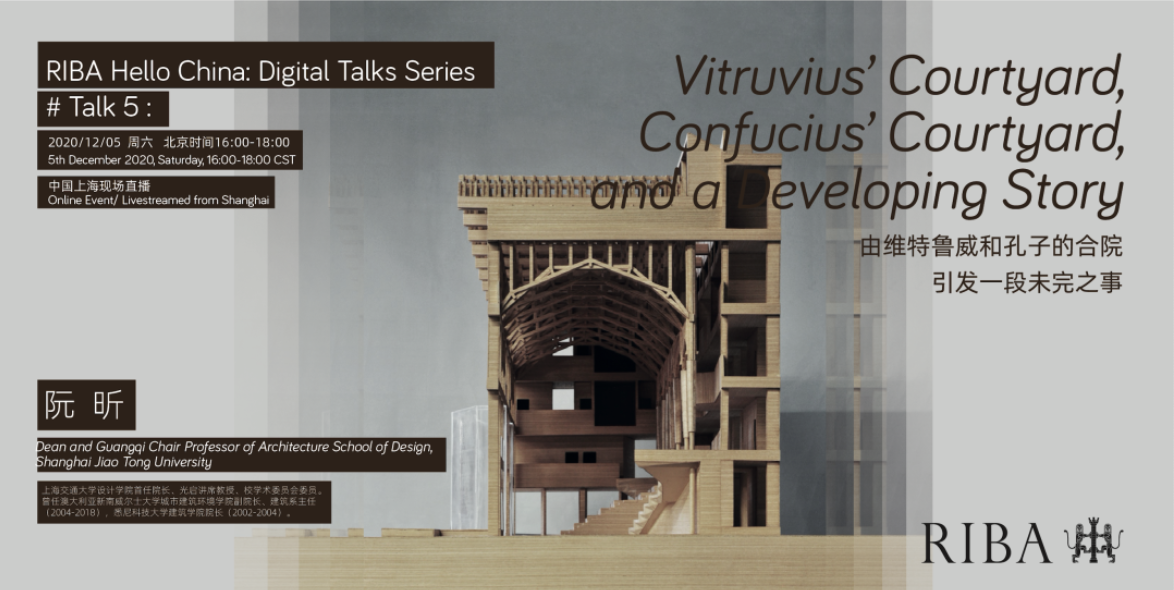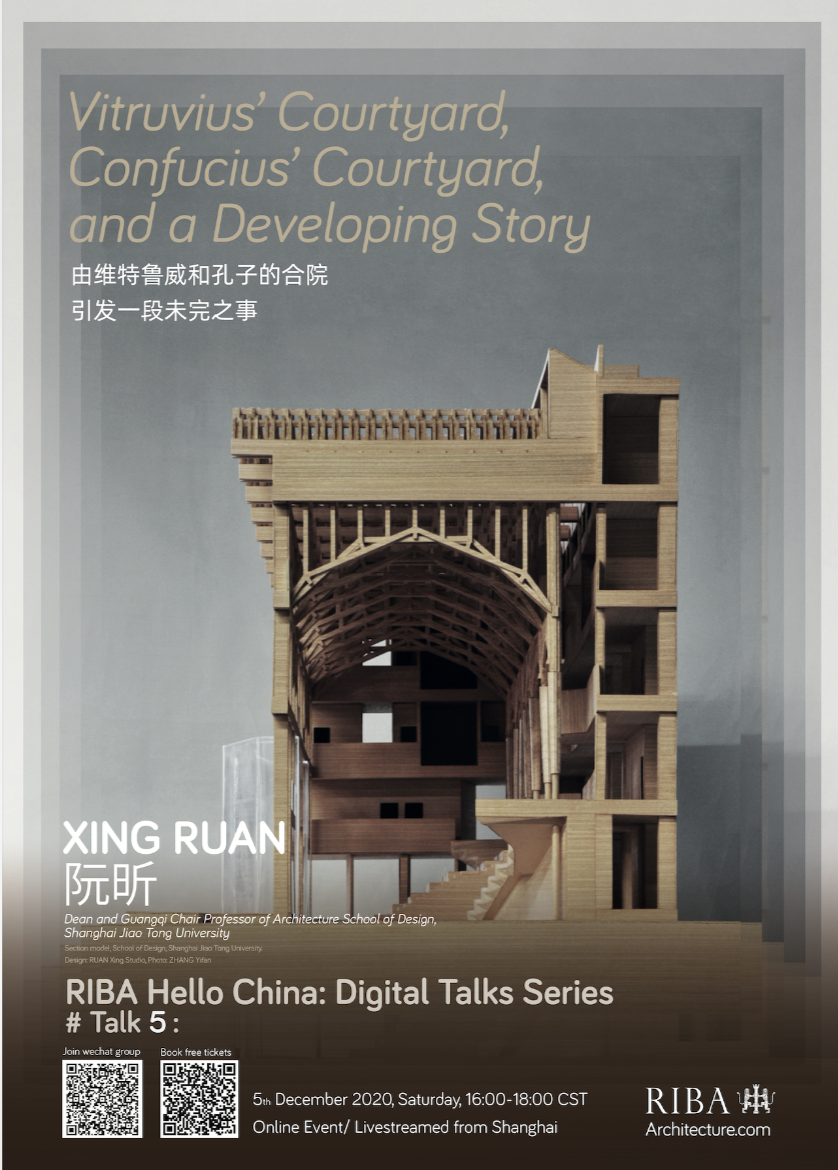RIBA TALK Pre | Xing RUAN 阮昕


RIBA Hello China: Digital Talks Series
#Talk 5
由维特鲁威和孔子的合院引发一段未完之事
Vitruvius’ Courtyard, Confucius’ Courtyard, and a Developing Story

阮昕,上海交通大学设计学院首任院长、光启讲席教授、校学术委员会委员。曾任澳大利亚新南威尔士大学城市建筑环境学院副院长、建筑系主任(2004-2018),悉尼科技大学建筑学院院长(2002-2004)。现任国际建筑师协会建筑评论家委员会 (CICA)委员、美国建筑历史学家学会(SAH)会员、澳大利亚建筑师学会(AIA)学术会员、新南威尔士大学建筑学长聘教授(2004-2020)、新南威尔士大学荣誉教授(2020-)、同济大学顾问教授。阮昕于2019年担任上海城市空间艺术季双年展“建筑与规划”策展人。阮昕在澳洲和中国都长期保持建筑实践。
阮昕着眼于历史文化背景中的建筑形制研究,涉猎中西建筑历史比较,世界居住史,风土民居与建筑文化人类学,建筑教育,当代建筑评论,以及西方文化语境下的亚洲建筑研究。学术专著包括:《浮生·建筑》(商务印书馆,2020), Allegorical Architecture ( University of Hawaii Press, 2006), New China Architecture (Periplus/Tuttle, 2006), Topophilia and Topophobia: Reflections on Twentieth-Century Human Habitat (Routledge 2007, 合著), Skyplane (UNSW Press 2009, 合著), Hand and Mind (UNSW Press 2018, 合著)。阮昕与著名文化地理学家那仲良(Ronald Knapp) 教授联合主编Spatial Habitus: Making and Meaning in Asia's Architecture ,目前已出版专著十二部,涵盖中国、日本、韩国、印度及中东。此丛书在全球学术界已建立权威地位。阮昕的学术论文及建筑评论发表于JSAH(美国《建筑史学家会刊》), 中国《建筑学报》《建筑师》,《文汇学人》及 AA(《澳洲建筑》)等期刊杂志。设计作品(与赵东敏合作)发表于澳洲、中国的设计杂志及报刊。
阮昕于2011年获国际建协(UIA) 建筑与都市设计论文国际竞赛奖。曾应邀于诸国际学术会议做主旨报告, 以及在中国、中国香港、马来西亚、新加坡、新西兰、澳大利亚、意大利、美国、阿根廷、英国和印度等大学与文化机构做公开演讲。其专著和学术论文得到了来自全球权威学术期刊及主流媒体的高度评价和广泛关注。他致力于将中国及亚洲的建筑文化传统置之于西方背景下作比较研究,其根本着眼点在于寻求中国及亚洲建筑文化在当今全球化政治及经济背景下的复兴之路。
Xing RUAN 阮昕
PhD, is Founding Dean and Guangqi Chair Professor of Architecture at School of Design, Shanghai Jiao Tong University. He is a member of Shanghai Jiao Tong University Academic Committee. Xing joined UNSW Sydney as Professor of Architecture in 2004. He was Associate Dean International (2015-18) and was Director of Architecture (2014-16), Chair of Architecture Discipline and Director of Master of Architecture from (2005-09). Prior to his appointment to UNSW, he was Head of School of Architecture at the University of Technology Sydney (2002-04). In 2019, he was the curator of Shanghai Urban Space Art Season biennale. Xing has maintained an architectural practice in both Australia and China.
Xing has published on a cultural history of housing, architecture and anthropology, vernacular architecture, architectural education, Louis Kahn and modern architecture, China’s pre-modern, modern and contemporary architecture, as well as Australian contemporary architecture. The titles of his books include: Fusheng Jianzhu [ Floating Life and Architecture 浮生·建筑] , 2020 ; Allegorical Architecture , 2006 ; New China Architecture , 2006 ; Hand and Mind , 2018 ; Topophilia and Topophobia, 2007. His books have received critical acclaim and enthusiastic appraisal both in academic journals and from some mainstream media outlets around the world.
Xing’s essays have appeared in leading academic and literary journals, such as JSAH (Journal of the Society of Architectural Historians), Jianzhu xuebao [Architectural Journal 建筑学报], Jianzhu shi [The Architect 建筑师] and Wenhui Xueren of Wenhui Ribao [Wenhui Scholar of Wenhui Daily 文汇学人, 文汇日报]. Xing is co-editor, with Ronald Knapp, of the book series Spatial Habitus: Making and Meaning in Asia’s Architecture published by the University of Hawai’i Press, with published titles encompassing China, Japan, Korea, India and the Middle East. He has also contributed, as a critic, to professional architecture journals in Australia and China.
Xing teaches architectural design, history and theory. He has been invited to give keynote and public lectures at conferences and universities in China, South-East Asia, India, USA, the UK, Italy, New Zealand, Argentina and Australia. He also serves as a supervisor for PhD and Master’s research degrees.

Section model, School of Design, Shanghai Jiao Tong University.
Design:Xing RUAN Studio
Photo: ZHANG Yifan
【Abstract】
From approximately 1000 BCE through to 500 BCE, the Chinese decided to abandon their subterranean huts to live in courtyard houses. At about the same time, the clever mortals on the shores of the Mediterranean Sea, too, built courtyard houses. But neither Vitruvius nor Confucius offer any explanation of the “heavenly house on earth”. Instead, Vitruvius speaks about the public character of the domus atrium and the owner’s civic duty, whilst Confucius teaches the meaning of societal decorum and morality through courtyard living. The Greek and Roman domus did not last for too long; the Chinese, to the bewilderment of others, continued to live in the courtyard house for more than 3000 years. A great divergence between the West and the East occurred, and the rest is history. Is there any need for striking a connection between these cultures in our time when distrust between the West and the Chinese is becoming seemingly unbridgeable? Through a modest venture – the building project of the Shanghai Jiao Tong School of Design, I have embarked upon a developing story.
